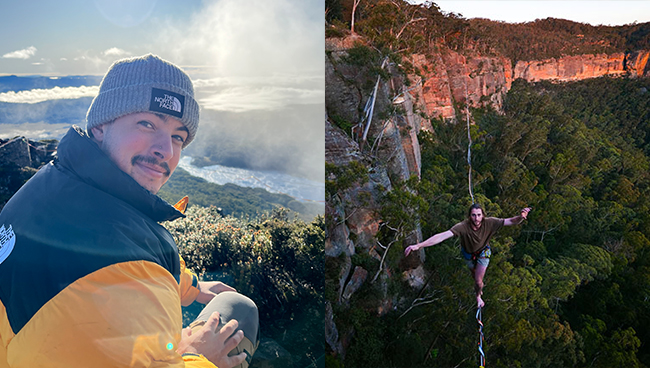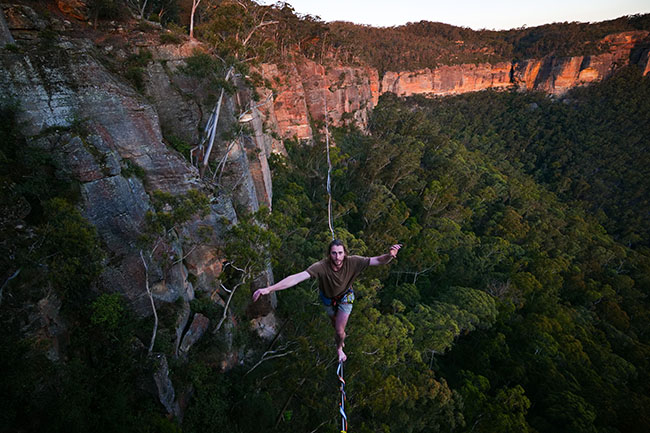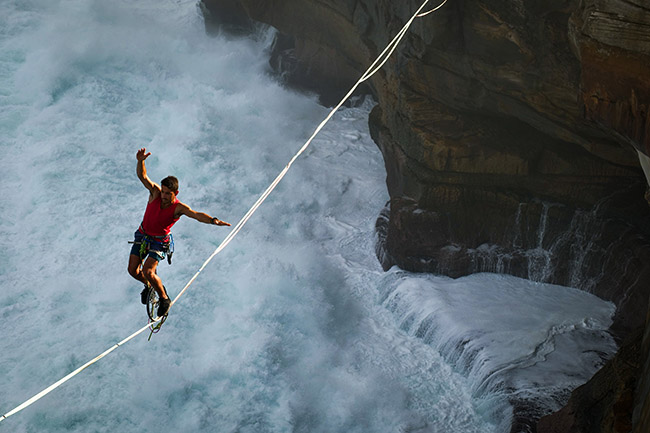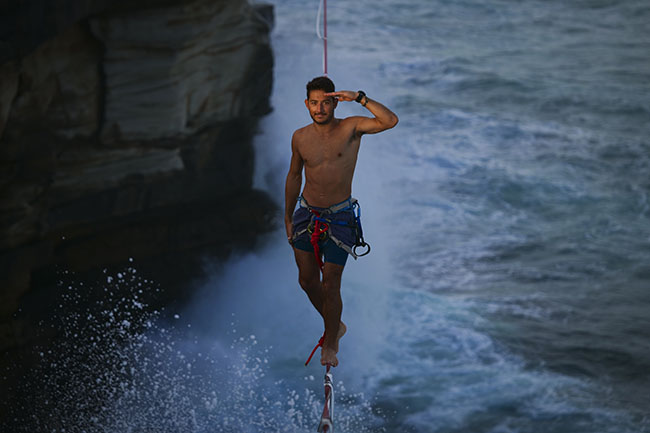
Meet Aidan Williams, a professional adventure sports photographer from the Blue Mountains. Starting at age five with a disposable film camera, Aidan’s passion evolved with his first point-and-shoot, seamlessly blending his love for the outdoors and photography. His internationally acclaimed work has earned honours from the International Photography Awards and features in National Geographic. Join Aidan as he shares his incredible journey.
Q: How did you get into slacklining photography in the first place?
Sometimes life presents an opportunity that feels like it was meant to be. Back in 2017, I was at a low point in my career as a press photographer. I was burnt out and desperately searching for something to rekindle my passion for photography. In an attempt to rejuvenate my creative spirit, I decided to take a two-week road trip to Tasmania. I roamed across the island with no specific destination in mind, just capturing whatever caught my eye.
During my final days in Tasmania, I heard from a fellow photographer, Krystle Wright, about a sport called ‘Highlining.’ It’s an elevated form of slacklining where participants walk along a one-inch-wide nylon/polyester line stretched between two fixed points high above the ground. Although I’d never witnessed it in person, something about the idea intrigued me.
I returned to Sydney with a renewed sense of hope, despite not having actually seen a Highliner in action. Sometimes, when you’re at your lowest, even the smallest spark can reignite your spirit. With every spare moment, I delved into learning about highlining, scouring the internet for more information and seeking out local practitioners. After weeks of persistence, I finally connected with a local Highliner who agreed to let me photograph him during a session.

Shot with LUMIX S1H and 16-35mm F4
The shoot was set for 5 p.m., just as the sun was setting. When I arrived, I saw the breathtaking silhouette of a Highliner crossing the skyline with such grace that it seemed like he was flying. In that moment, I knew I’d found my new calling. Two months later, I quit my job and booked a one-way ticket to France, where I was told there was a thriving community of Highliners. It was a bold move, but sometimes you have to follow your heart, even if it leads you halfway across the world.
Q: What are the challenges you often face when shooting slacklining? (Is there any lesson/experience that is very important/memorable for you?)
Slacklining presents a variety of unique challenges, from the physical demands of hiking to remote locations and managing heavy gear to the psychological pressures of working at great heights and executing world-record projects where there’s only one shot at success. There are also weather-related hurdles, like dealing with snowstorms, sandstorms, or even massive waves crashing in from places like Nazare. Whether it’s hauling equipment up a mountain or maintaining focus during unpredictable conditions, each shoot is a test of endurance and resilience. Every time I get the chance to shoot a slacklining project, I come away with a valuable lesson. If I’m not learning, then I’m either doing something wrong or not pushing my limits to improve.

Shot with LUMIX S1H and 70-200 F2.8
One shoot that stands out was in Moleson, Switzerland. At 2,002 meters above sea level, Moleson is a prime spot for tourists to enjoy 360-degree panoramic views of the stunning Swiss landscape. I was commissioned by the tourism department to capture Highliners rigging a line at the summit. Initially, the setup seemed straightforward, but the weather quickly turned against us, presenting a whole new set of obstacles. We were hit by intense snowstorms, with freezing winds and horizontal snow that made shooting incredibly challenging. While the Highliners continued to walk the line despite the harsh conditions, I knew I had to keep shooting. If they could brave the storm, then so could I. It was a test of grit and adaptability, reminding me that even in the toughest situations, there’s always an opportunity to capture something extraordinary.
Q: How did you overcome the challenges and what are the tips for people start leaning about this space?
I navigated the hurdles of shooting in a snowstorm by taking a few key precautions. First, I used a protective cover for my camera along with a lens hood, which, while not a complete shield, helps reduce the amount of snow hitting the lens in high winds. A UV filter or similar water-resistant coating is essential to keep the lens protected. To counter the cold’s impact on battery life, I kept extra batteries in my pocket to stay warm, as cold temperatures drain batteries more quickly. I also made sure to have microfiber cloths, lens pens, and blowers on hand to clean the lens when needed. Staying warm was equally important, so I wore a down jacket, insulated pants, thick socks, sturdy shoes, and a beanie. A buff proved useful for various purposes, including covering my face or neck when the wind picked up. Gloves were a must for keeping my hands warm while still allowing me to operate the camera efficiently. By following these steps, I was able to overcome the challenges posed by the severe weather conditions and capture the shots I needed.

Shot with LUMIX S1H and 70-200 F2.8
Q: How does the equipment play a role to you? What is your favourite gear and why?
Equipment is crucial when planning a photography project, especially in challenging environments like remote highlining locations. Each piece of gear must be carefully selected and customized to fit the project’s specific requirements and the types of shots you aim to capture. Weight is a significant consideration, as everything must be carried on your back, including food, water, clothing, climbing, and highlining equipment, along with all your photography gear. My go-to setup includes the LUMIX S1H for its outstanding stills capabilities, paired with the 70-200mm f/2.8 S series lens. This combination has proven to be exceptionally reliable and delivers consistently sharp results. It’s robust enough to withstand the demands of the environment, and I know I can count on it to get the job done, no matter the conditions.

Shot with LUMIX S1H and 16-35mm F4
Q: Do you have any exciting projects coming or any plan to further develop your passion?
I’m thrilled about what’s coming up this year. I’ve got a couple of passion projects in the works that I can’t wait to dive into, including shooting two supermoons later in the year and possibly capturing another Australian record. I also want to focus on improving my documentary style, which I think could really transform how I approach my projects. This shift in perspective should help me discover new angles and creative techniques for my photography, keeping my work fresh and inspiring.
